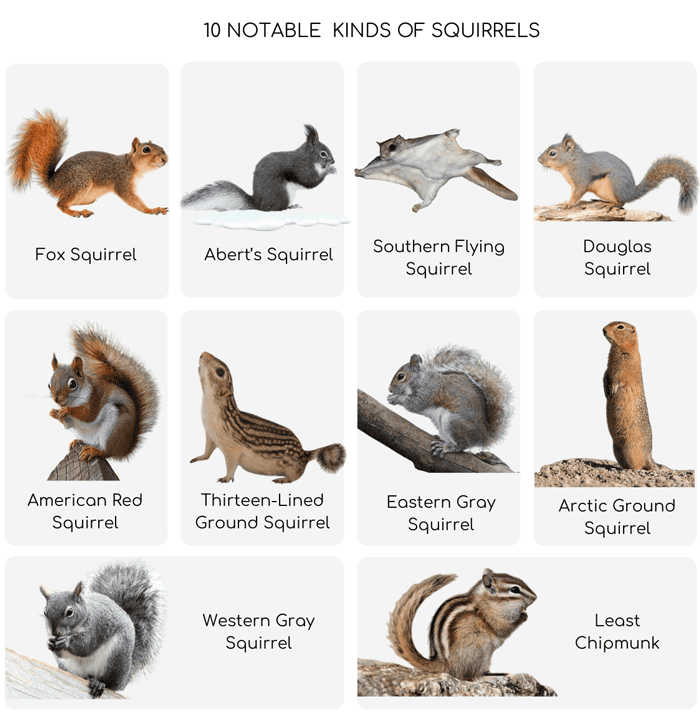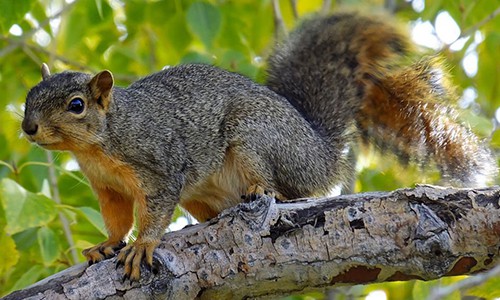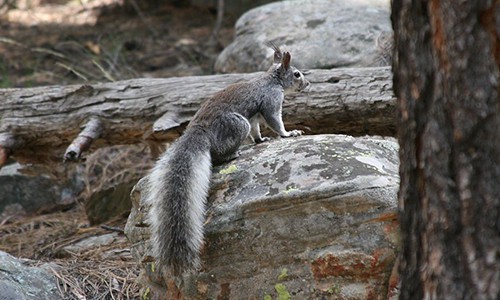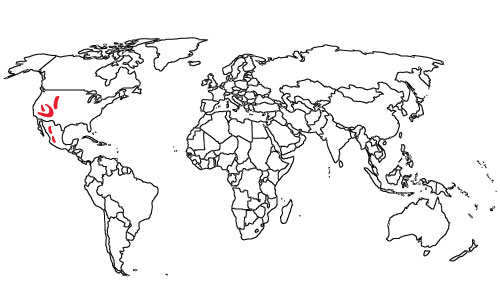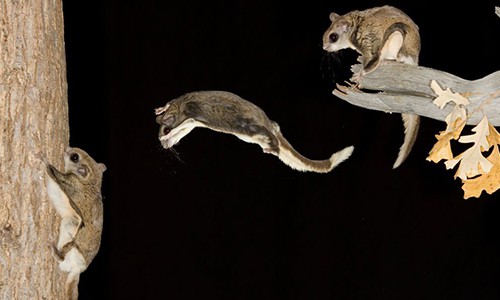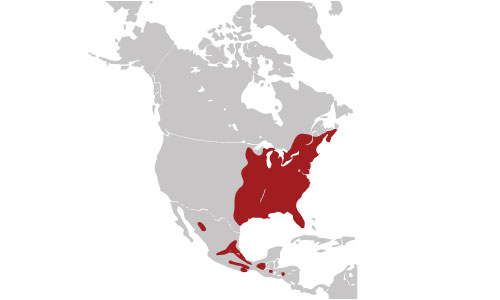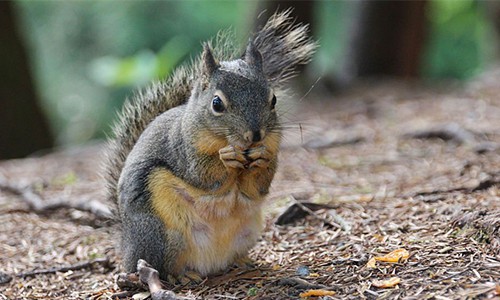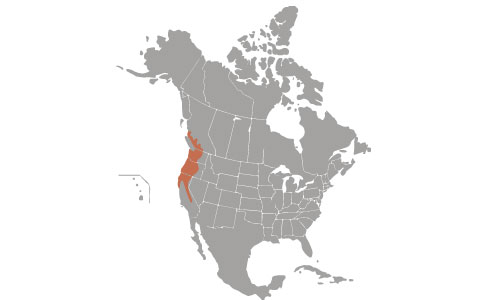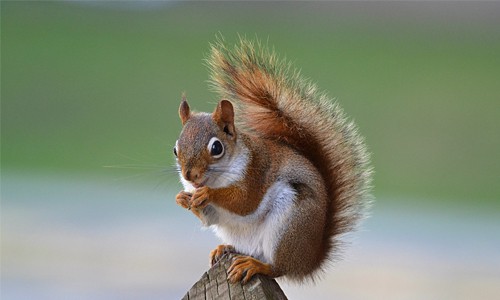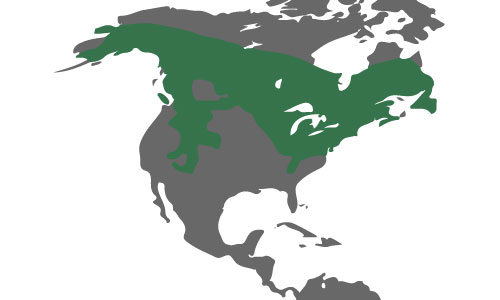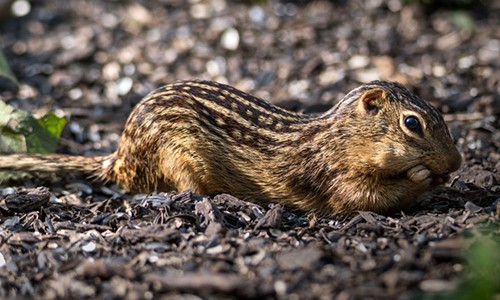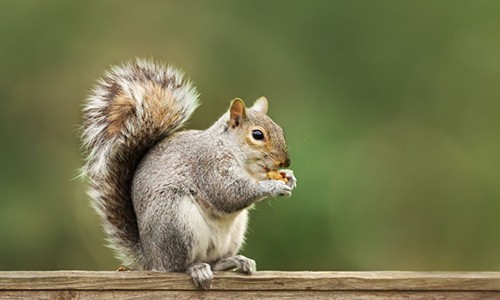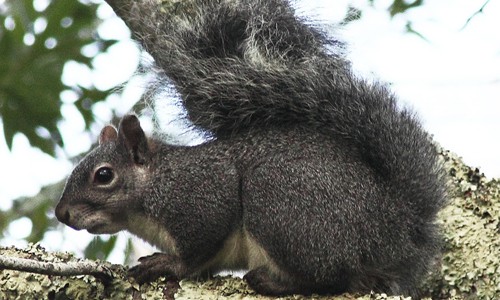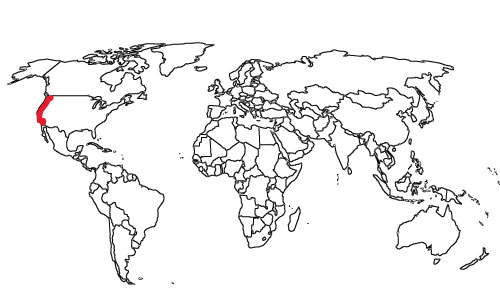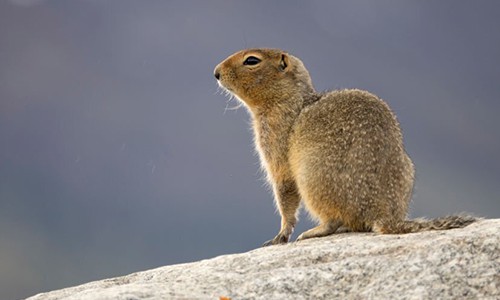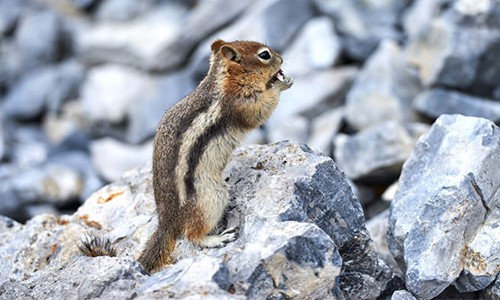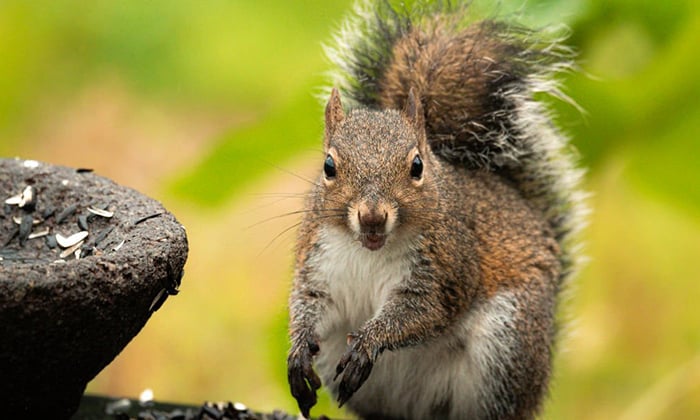There are over 280 different types of squirrels in the world, with 68 of them residing in the United States.
To many, they look like just a single species in varying degrees of brown, red, and black. It will take a keen eye and knowledge about their distinguished features to tell them apart.
How many types of squirrels in North America can you name? Many will mention the flying or ground squirrel. But did you know there are also subspecies, like 24 kinds of ground squirrels and 2 kinds of flying squirrels?
Let’s learn some of the most common squirrel breeds and how to differentiate them.
Different Kinds of Squirrels
It might be tricky to memorize all 65 squirrel species, so let’s start with a few notable ones you should know about. Let’s get acquainted with these 10 different squirrel species with pictures.
1. Fox Squirrel
Scientific Name: Sciurus niger
Weight Range: 500 to 1000 grams
Approximate Length: 45 to 70 centimeters
Also referred to as the Eastern Squirrel or Bryant’s Fox Squirrel. The Fox squirrel has strong hind legs and long, bushy tails. Their color and pattern change depending on which region they inhabit.
American squirrels come with brownish fur, whereas they often sport a black coat in the southern regions.
These large squirrels ranked first in size among all its species. While fox squirrels can adapt to different habitats, they mostly live in deciduous and mixed forests in Eastern America.
Their population range extends to the Central United States, southern Canada, and northern Mexico.
Fox squirrels prefer solitude, but partners sometimes share the same nest and feeding area with other squirrels of the same species.
These diurnal animals spend most days foraging on the ground, chasing other squirrels, and climbing trees. Despite being solitary animals, this species is socially graceful, even in urban areas.
2. Abert’s Squirrel
Scientific Name: Sciurus aberti
Weight Range: 540 to 971 grams
Approximate Length: 46 to 58 centimeters
Abert’s Squirrel is known for their tufted ears; thus, they are sometimes called the tassel-eared squirrel.
However, you might notice that their ear tassels are smaller or almost nonexistent during the summer. Other distinct features of this species are their bushy tail, long rear paws, strong hind legs, and white underside.
The tassel-eared squirrel inhabits coniferous forests abundant with ponderosa pine trees, as these are a main part of their diet. Their population is mainly isolated to the southern Rocky Mountains area, extending north of Sierra Madre Occidental, Mexico. Since they are not territorial, some of their home ranges sometimes overlap.
These squirrels are busy throughout the year. Abert’s Squirrels can weather through the cold by only leaving their nests to forage. They can leap from one branch to another and are skilled at climbing.
3. Southern Flying Squirrel
Scientific Name: Glaucomys volans
Weight Range: 56.6 to 85 grams
Approximate Length: 19.6 to 25.4 centimeters
The Southern Flying Squirrel is the smaller of the only two subspecies of flying squirrel in the United States. They have a small face, rounded face, black eyes, and tiny, pointed ears. The all-white belly hair between their front legs sets them apart from their northern counterparts.
Squirrels dwell in tree cavities, and this species is no exception. They live in the mixed and deciduous forests from Florida to Canada, where there are old and seed-bearing trees. You can also find a population of these squirrels in southeastern Canada and Mexico.
In the winter, you won’t find these nocturnal animals hibernating; instead, they would huddle together with other squirrels.
4. Douglas Squirrel
Scientific Name: Tamiasciurus douglasii
Weight Range: 141 to 312 grams
Approximate Length: 27 to 35.5 centimeters
Sometimes called pine squirrel or chickaree, Douglas Squirrel is often mistaken for American Red Squirrel because of their identical size, overlapping territories, and similar nicknames.
To differentiate the two, remember that the Douglas Squirrel has a dark-brownish gray back, white eye ring, chestnut, orange belly, and orange-colored front teeth.
Douglas Squirrels are endemic to the conifer forests of the Pacific Northwest, where they can feast on conifer seeds and fungi. They have a decent population in western Washington, central Oregon, northwestern California, and Sierra Nevada.
Just like other scansorial animals, these squirrels are great at jumping and climbing trees. They are equipped with strong claws and sturdy tails. Despite their preference for solitude, Douglas Squirrels can be very noisy when alarming others of dangers.
5. American Red Squirrel
Scientific Name: Tamiascuriurus hudsonicus
Weight Range: 197 to 282 grams
Approximate Length: 27 to 38.5 centimeters
With the same nickname and coloration as other species, it’s challenging to distinguish these red squirrels.
Some features to look out for are the white around its eyes, white underside, large ear tufts, and bushy tail edged with white. The black stripes on their sides appear during summer.
These American squirrels’ habitats are deciduous, coniferous, and mixed forests. Their population is scattered around several continents, including the Rocky Mountains, southern Alaska, coastal British Columbia, most of Canada, and the Atlantic coast.
Spring and summer are when American Red Squirrels are active in the early mornings and late afternoons.
In winter, they forage all day to prepare for the cold nights. These squirrel species are very expressive with their voice and will growl, chatter, and screech depending on the situation.
6. Thirteen-Lined Ground Squirrel
Scientific Name: Ictidomys tridecemlineatus
Weight Range: 110 to 140 grams
Approximate Length: 22.5 to 30 centimeters
Thirteen-Lined Ground Squirrels have many nicknames, such as Squinney and striped gopher.
Just like its name, this ground squirrel has 13 distinctive dark brown and tan stripes running from the middle of its eyes to the base of its tail. Their small and slim bodies match their short ears and slender tails.
This brown squirrel can be found across the open areas of central North America and Canada. Their population extends far west, all the way to Arizona and Montana, and far east in Ohio.
They tend to steer clear of wooded areas and prefer open areas with loamy or sandy soils ideal for burrowing.
Like the majority of squirrel species, Thirteen-Lined Ground Squirrels are diurnal. They hibernate and nest in shallow blind-end burrows, which they also use when threatened.
These squirrels are true hibernators, dropping their body temperatures and slowing their heartbeats when winter comes.
7. Eastern Gray Squirrel
Scientific Name: Sciurus carolinensis
Weight Range: 338 to 750 grams
Approximate Length: 38 to 52.5 centimeters
Although called gray squirrel, the species actually has brown, black, and white fur. Their flat bushy tails are tinted with white on the tip, and light gray to white on the underside. Albinism is rare in this species. Still, melanism is common for those in the northern part of their population range.
The Eastern Gray Squirrel is widespread in eastern North America. They inhabit temperate regions with uninterrupted woodlands of mature trees and diverse vegetation. You can also find these squirrels in some urban and suburban areas.
These squirrels have a propensity for escaping foraging when the temperature is high. They are most active before sunrise and after sunset. Since these squirrel species feed on nuts and seeds, they frequent bird feeders and are considered pests by many homeowners.
8. Western Gray Squirrel
Scientific Name: Sciurus griseus
Weight Range: 408 to 998.7 grams
Approximate Length: 45 to 60 centimeters
While it is often confused with its eastern counterpart, the Western Gray Squirrel is easily discernible. They are slightly bulkier, steel gray, and have more prominent reddish-brown back ears. Another distinguishing feature of this specie is their long bushy gray tails with white edges.
Western Gray Squirrels are native to the Pacific Northwest and are the largest tree squirrels in the region. Their range covers the Mediterranean forests and temperate coniferous forests of northern Mexico, northern Washington State, and the north edge of Baja in California.
This silver-gray squirrel spends most of its time foraging, grooming, and examining the environment outside the nest. Its well-developed and excellent sense of smell makes it great at finding stored excess food. When threatened, it will flick its tail and stamp its feet while barking.
9. Arctic Ground Squirrel
Scientific Name: Urocitellus parryii
Weight Range: 100 to 750 grams
Approximate Length: 21.5 to 25 centimeters
The Arctic Ground Squirrel is the largest ground squirrel species in North America. They have white spots on their brown fur and four toes on their stubby legs. Their color changes in the spring and winter to adapt to the cold weather.
These burrowing squirrels are native to the mountainous regions of Denali and all over Alaska. Their population is limited to open meadows, forest clearings, river valleys, and the Arctic tundra due to the well-drained soil and permafrost. This allows them to build a maze of tunnels for multiple burrows, thus improving soil aeration.
Arctic Ground Squirrels live in colonies with a minimum of 5 and a maximum of 50 squirrels consisting of a dominant male, females, and their offspring.
They are unique species that hibernate for 7 to 8 months using a method called supercooling – a process that keeps their blood in liquid form, even when it has reached sub-zero temperatures.
10. Least Chipmunk
Scientific Name: Neotamias minimus
Weight Range: 25 to 66 grams
Approximate Length: 15.7 to 25 centimeters
Small squirrels are called chipmunks, and the smallest species among them is the Least Chipmunk. This dark brown squirrel is greyish in the winter since it undergoes molting twice every year.
Other notable features of this chipmunk are its short hair covering its short ears, long tail, cheek pouches, and stripes on its back.
While native to North America, they also inhabit sagebrushes and coniferous woodlands in Canada, extending from Yukon to British Columbia and Quebec. This species is the most widespread among all chipmunks and has an abundant population throughout most of the country.
The least Chipmunks are most active during the days of April and October. They are solitary, except during breeding season when they mate and raise their young. Unlike most squirrels, these chipmunks are very territorial, especially when defending their nests.
How to Identify Different Types of Squirrels
With many species available in the wild, squirrel identification can be a real challenge. However, even those who are new to learning about squirrels can master the art of distinguishing them. You need to know what to look out for.
- A side-by-side look at the species chart is a great way to start.
Notice their physical appearance, squirrel colors, sizes, the length of their body, including the tail, and the patterns on their bodies.
- The location also plays a significant consideration when identifying a squirrel.
Some squirrels are more common in one area than another and are almost nonexistent in some places. For example, ground squirrels prefer regions with loamy soil where they can easily dig, while tree squirrels are more common in forests with tall trees.
- Lastly, how the squirrel behaves can give you a clue about what species they are.
Most squirrels are diurnal, but if you see one active at night, it might be the Northern Flying Squirrel. Besides, there are species that frequent bird feeders more than others.
Conclusion
Now that you have expanded your knowledge about the different types of squirrels, we hope you found everything you’ve read here to be helpful. Next time you cross paths with a squirrel, you can now easily identify them. It’s tricky to familiarize yourself with the squirrel varieties, but this is a great start.
Share this article with anyone who might like to learn more about squirrels!

George and I became friends after a birdwatching trip with our new group. And we have been enjoying every adventure together. When he told me the idea of establishing a site that shares our experiences and fun, I immediately agreed. After trials and errors, here we have Thayerbirding.



